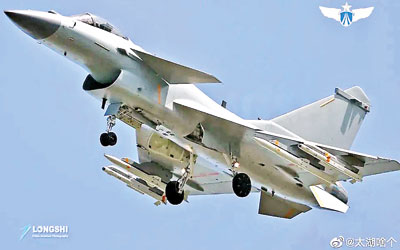Sunday Times 2
How China helped Pakistan shoot down Indian fighter jets
View(s):By Memphis Barker
At 4 a.m. Wednesday May 7, China’s ambassador to Pakistan hurried to the foreign ministry to celebrate an unprecedented military success.
Pakistan had reportedly shot down several Indian aircraft in the hours before using Chinese J-10C fighter jets.
“Our jet fighters… shot down three Indian Rafales, three Rafales [that] are French,” Ishaq Dar, Pakistan’s foreign minister, told parliament on Wednesday. “Ours were J-10C.”

Fighter jets armed with PL-15 missiles reportedly used by Pakistan
The Chinese delegation, roused from their sleep by the outbreak of conflict between two nuclear-armed nations, was thrilled with the success of the Pakistani defence, Mr Dar said.
“Being a friendly nation, they expressed great happiness.”
India has not officially responded to reports that it lost as many as five fighter jets. But the apparent involvement of Chinese aircraft in shooting down a Rafale has ricocheted through defence circles – and sent stock in its maker, Chengdu Aircraft Corporation, surging by as much as 20 percent.
Until now, Chinese weaponry had not been field-tested against Western-made systems like the Rafale. The Indian Air Force (IAF) operates a fleet of 36 Rafale F3Rs, the most advanced model of the aircraft.
A French intelligence source confirmed to CNN that at least one had been shot down, marking the first time a Rafale has been lost during combat.
In an official statement, China’s foreign ministry said it was “not familiar with the matter” when asked whether Chinese jets were involved in the skirmish.
Later, a US official told Reuters that there was “high confidence” a J-10C had shot down two Indian fighters, using air-to-air missiles.
That appeared to confirm the aircraft first known “kill”, having entered service in its earliest form in 2003. It has been described as a “4.5 generation fighter”, like the British Eurofighter Typhoons and almost at the level of fifth generation systems like the US-made F-35.
Hu Jixin, the former editor of the Chinese state-owned Global Times, said the battle showed that “China’s level of military manufacturing has completely surpassed that of Russia and France”, adding that Taiwan should feel “even more scared”.
Defence analysts remain cautious of reading too much into the technological battle between the two systems. Pilot error, or the rules of engagement, could have contributed to the Indian Rafale’s demise.
But open-source intelligence analysts are poring over images of the wreckage of a Chinese-made PL-15 missile, broadcast on Indian television and shared on social media.
The missile, which is carried by the J-10C, has never been used in combat before. But its ability to fire at targets far beyond the visual range of pilots appears to fit with the outlines of the clash on Wednesday May 7 morning.
Neither Pakistani nor Indian aircraft crossed the border, engaging instead in a “stand-off” conflict at a distance of more than 100km at times. The wreckage of a Rafale was discovered near the city of Bathinda deep inside India, according to multiple open-source analysts.
China’s development of the PL-15 prompted the US military to invest in a missile specifically designed to outrange it.
The PL-15E, the version exported to the Pakistani armed forces, can travel up to 145km, somewhat less far than the domestic equivalent.
Chinese military observers have long viewed it as a “very capable missile”, said Fabian Hoffmann, a missile technology researcher and non-resident fellow of the Centre for European Policy Analysis.
“But obviously [if a hit is confirmed] this is now a very public demonstration of the prowess of Chinese military aerospace technologies” that “carries outside the bubble”.
“This is another point of indication that, if there was a Taiwan conflict, you probably should not assume that Chinese technology would fail at the same rate as Russia’s during the war in Ukraine.”
On April 29, with cross-border tensions rising, Pakistan’s army published a YouTube video showcasing its military arsenal.
In the video, a Chinese-made JF-17 Block 3 fighter jet, less advanced than the J-10C, can be seen equipped with PL-15 missiles. The combination offers “potent punch”, a caption reads.
For pilots in the Pakistani Air Force, the PL-15 missile has several advantages. Once fired, it has a large rocket booster that briefly propels the projectile to above Mach 5, or hypersonic, speeds.
In the middle of its flight, it is guided to target by an active electronically scanned array (AESA) radar that can be held on the launch system or a separate vehicle. Close to the target, it switches on its own AESA radar, locks on, and homes in with deadly accuracy.
A dual-pulse motor means that, after the initial blast falls away, a second burst of speed can be generated within 10 or so kilometres from the target.
“Because they are very, very fast, they basically have what you call a ‘no-escape zone’,” Mr Hoffmann said.
The switch from the first radar system to the missile’s onboard version also allows the jet that launched it to turn away from the target and flee any counterfire.
“There’s survivability for the [launch] platform, but also lethality for the [missile] itself.”
When India and Pakistan clash, so do their military backers. In recent years, the two nations have rapidly diverged in terms of where they source their weaponry.
Now, Islamabad buys the vast majority of its arms from China. Some 82 percent of imports between 2019 and 2023 came from its “iron brother”, according to the Stockholm International Peace Research Institute (SIPRI), which tracks global arms flows.
Imports from the US, meanwhile, have collapsed.
At the same time, Delhi has stepped up arms purchases from Western allies and reduced its reliance on Russia. Since 2006, purchases from France, Israel and the US have surged. Imports from Moscow have fallen from 75 percent of the total to 36 percent, according to the SIPRI.
“The big advantage the Pakistanis have is that their primary weapon supplier is China,” said Dr Walter Ladwig, an associate fellow at the Royal United Services Institute, a London-based think tank.
“The Indian defence budget is bigger on paper, the modernisation budget is bigger.”
But Beijing “delivers”. It has rapidly supplied Pakistan with armour, a jointly developed fighter jet (in the form of the JF-17 Block 3) and missile systems.
For various reasons, India’s main suppliers, Russia and France (who provide 36 percent and 33 percent of imports respectively) have been slower to fulfil their orders, said Dr Ladwig. India’s air force is “still operating these antiquated MiGs,” he added.

